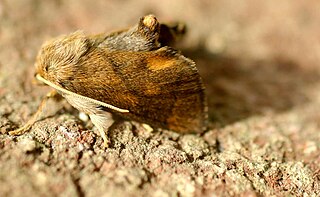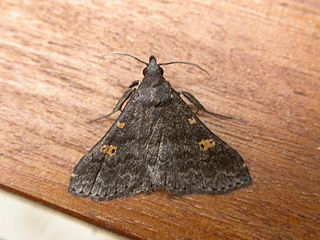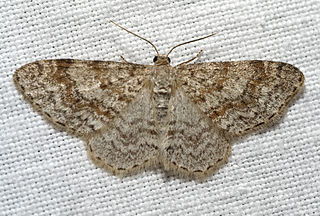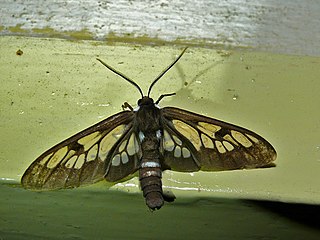
The flannel moths or crinkled flannel moths are a family of insects. They occur in North America and the New World tropics. The larvae are called puss caterpillars, and with their long hairs, resemble cotton balls. They have venomous spines that can cause a painful sting and inflammation lasting for several days. In some cases, the sting may cause headache, nausea, and shock-like symptoms. Perhaps the most notorious for stinging is the caterpillar of Megalopyge opercularis.

The Drepanidae is a family of moths with about 660 species described worldwide. They are generally divided in three subfamilies which share the same type of hearing organ. Thyatirinae, previously often placed in their own family, bear a superficial resemblance to Noctuidae. Many species in the Drepanid family have a distinctively hook-shaped apex to the forewing, leading to their common name of hook-tips.

The Pyraloidea are a moth superfamily containing about 16,000 described species worldwide, and probably at least as many more remain to be described. They are generally fairly small moths, and as such, they have been traditionally associated with the paraphyletic Microlepidoptera.

Endoclita is a genus of moths of the family Hepialidae. There are 60 described species found in eastern and southeast Asia and the Indian subcontinent.

The Limacodidae or Eucleidae are a family of moths in the superfamily Zygaenoidea or the Cossoidea; the placement is in dispute. They are often called slug moths because their caterpillars bear a distinct resemblance to slugs. They are also called cup moths because of the shape of their cocoons.

Callidulidae, the only known family of the superfamily Calliduloidea, is the family of Old World butterfly-moths, containing eight genera. They have a peculiar distribution, restricted to the Old World tropics of South East Asia to Australasia and Madagascar. The three subfamilies exhibit both day- and night-flying behaviour.

Naarda is a large genus of erebid moths currently encompassing 108 species. Initially identified by Francis Walker in 1866, it is in the family Erebidae. Somewhat ruddy in appearance, this genus is distinguishable for its generally slender thorax and abdomen, and straight, porrect labial palpi. Most species are a light tan color, but shading can reach as deep as a charcoal, with muddy yellow, conspicuous reniform, orbicular stigmata featured on the forewings, sometimes reflected bilaterally superior.
Mantala is a monotypic moth genus in the subfamily Arctiinae. Its single species, Mantala tineoides, is found on Borneo. Both the genus and the species were first described by Francis Walker in 1862. The habitat consists of lowland and lower montane forests.

Ugia is a genus of moths in the family Erebidae erected by Francis Walker in 1858.
Hypenagonia is a genus of moths of the family Erebidae first described by George Hampson in 1893. The adult moths have pale brown wings with a dark band across each wing. The wingspan of these moths is about 1 centimeter.

Asthenini is a tribe of geometer moths under subfamily Larentiinae first described by Warren in 1893. The tribe has been combined with Eupitheciini in the past, most notably by Jeremy Daniel Holloway in his work The Moths of Borneo.

The Erebinae are a subfamily of moths in the family Erebidae erected by William Elford Leach in 1815. Erebine moths are found on all continents except Antarctica, but reach their greatest diversity in the tropics. While the exact number of species belonging to the Erebinae is not known, the subfamily is estimated to include around 10,000 species. Some well-known Erebinae include underwing moths (Catocala) and witch moths (Thermesiini). Many of the species in the subfamily have medium to large wingspans, up to nearly 30 cm in the white witch moth, which has the widest wingspan of all Lepidoptera. Erebine caterpillars feed on a broad range of plants; many species feed on grasses and legumes, and a few are pests of castor bean, sugarcane, rice, as well as pistachios and blackberries.

Lymantriini is a tribe of moths of the family Erebidae. This tribe is a group of polyphagous moths that reside mostly in the tropical regions of Afro-Eurasia but also North America.
The Catephiini are a tribe of moths in the family Erebidae.
Caeneressa brithyris is a moth of the family Erebidae. It was described by Herbert Druce in 1898. It is found on Borneo and Sumatra.
Caeneressa longipennis is a moth of the family Erebidae. It was described by Francis Walker in 1862. It is found on Borneo. The habitat consists of lowland areas.
Caeneressa lutosa is a moth of the family Erebidae. It was described by Jeremy Daniel Holloway in 1976. It is found on Borneo.

Caeneressa robusta is a moth of the family Erebidae. It was described by Jeremy Daniel Holloway in 1976. It is found on Borneo.
Caeneressa sexpuncta is a moth of the family Erebidae. It was described by Rothschild in 1912. It is found on Borneo. The habitat consists of lowland forests.
Caeneressa syntomoides is a moth of the family Erebidae. It was described by Rothschild in 1912. It is found on Borneo. The habitat consists of lowland forests.












